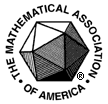
|
Mathematical Association of America |
|
James P. Keener's Abstract |
||
|
Title: How cells make measurements
Abstract: Bacteria need math, too. They need to count and make a variety of measurements in order to survive in a constantly changing environment. The purpose of this talk is to use mathematics (primarily ordinary differential equations) to show how bacterial cells can extract quantitative information from their environment. This will be illustrated with two specific examples: Example 1: Bacterial populations of P. aeruginosa are known to make a decision to secrete polymer gel on the basis of the size of the colony in which they live. This process is called quorum sensing and only recently has the mechanism for this been sorted out. It is now known that P. aeruginosa produces a chemical whose rate of diffusion out of the cell provides quantitative information about the size of the colonly in which it exists, which when coupled with a positive feedback biochemical network gives a hysteretic switch. Example 2: Salmonella regrow their flagella if they are broken off, indicating that the bacteria are able to measure the length of their flagella. They are able to do this because of a biochemical network with negative feedback coupled with a length dependent rate of efflux of a secreted molecure. |
||
|
March 23-24, 2007, Salt Lake City, Utah
|
||